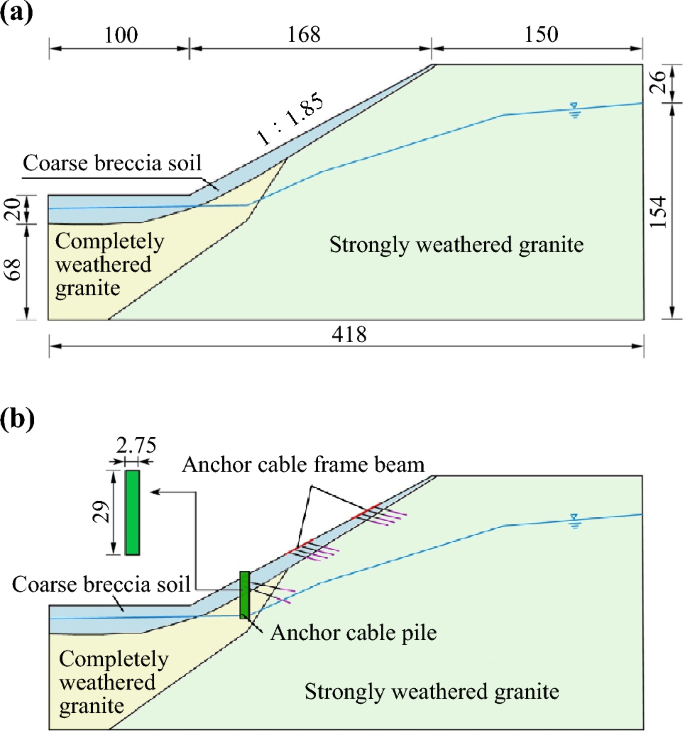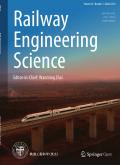降雨作用下松散堆积边坡稳定性分析——以西南某高速铁路为例
IF 5.4
1区 工程技术
Q2 TRANSPORTATION SCIENCE & TECHNOLOGY
引用次数: 0
摘要
西南山区某高铁沿线高陡边坡多为松散堆积体,内部孔隙大,稳定性差,在降雨条件下易诱发不良地质灾害。为保证高速铁路的顺利施工和后续的安全运行,有必要掌握降雨作用下松散堆积体边坡的稳定性演变过程。本文利用有限元分析软件的水-力耦合模块对降雨进行模拟。采用强度折减法对不同降雨条件下的边坡稳定性进行了计算和分析。为了验证模拟结果,建立了现场监测系统,研究了降雨作用下边坡的变形特征。结果表明,降雨持续时间是影响边坡稳定性的关键因素。在一定的降雨量下,边坡的稳定性随着降雨持续时间的增加而降低。在降雨量和持续时间一定的情况下,连续降雨对边坡稳定性的影响大于间歇降雨。场地围护结构的设置对提高边坡稳定性具有重要作用。现场监测数据表明,边坡处于初始变形阶段,具有较好的稳定性,验证了数值模拟方法的合理性。研究结果可为了解降雨对高速铁路沿线松散堆积体边坡稳定性的影响及建立监测体系提供一定的参考。本文章由计算机程序翻译,如有差异,请以英文原文为准。

Stability analysis of loose accumulation slopes under rainfall: case study of a high-speed railway in Southwest China
Abstract The high and steep slopes along a high-speed railway in the mountainous area of Southwest China are mostly composed of loose accumulations of debris with large internal pores and poor stability, which can easily induce adverse geological disasters under rainfall conditions. To ensure the smooth construction of the high-speed railway and the subsequent safe operation, it is necessary to master the stability evolution process of the loose accumulation slope under rainfall. This article simulates rainfall using the finite element analysis software’s hydromechanical coupling module. The slope stability under various rainfall situations is calculated and analysed based on the strength reduction method. To validate the simulation results, a field monitoring system is established to study the deformation characteristics of the slope under rainfall. The results show that rainfall duration is the key factor affecting slope stability. Given a constant amount of rainfall, the stability of the slope decreases with increasing duration of rainfall. Moreover, when the amount and duration of rainfall are constant, continuous rainfall has a greater impact on slope stability than intermittent rainfall. The setting of the field retaining structures has a significant role in improving slope stability. The field monitoring data show that the slope is in the initial deformation stage and has good stability, which verifies the rationality of the numerical simulation method. The research results can provide some references for understanding the influence of rainfall on the stability of loose accumulation slopes along high-speed railways and establishing a monitoring system.
求助全文
通过发布文献求助,成功后即可免费获取论文全文。
去求助
来源期刊

Railway Engineering Science
TRANSPORTATION SCIENCE & TECHNOLOGY-
CiteScore
10.80
自引率
7.90%
发文量
1061
审稿时长
15 weeks
期刊介绍:
Railway Engineering Science is an international, peer-reviewed, and free open-access journal that publishes original research articles and comprehensive reviews related to fundamental engineering science and emerging technologies in rail transit systems, focusing on the cutting-edge research in high-speed railway, heavy-haul railway, urban rail transit, maglev system, hyperloop transportation, etc. The main goal of the journal is to maintain high quality of publications, serving as a medium for railway academia and industry to exchange new ideas and share the latest achievements in scientific research, technical innovation and industrial development in railway science and engineering. The topics include but are not limited to Design theory and construction technology System dynamics and safetyElectrification, signaling and communicationOperation and maintenanceSystem health monitoring and reliability Environmental impact and sustainabilityCutting-edge technologiesThe publication costs for Railway Engineering Science are fully covered by Southwest Jiaotong University so authors do not need to pay any article-processing charges.
 求助内容:
求助内容: 应助结果提醒方式:
应助结果提醒方式:


